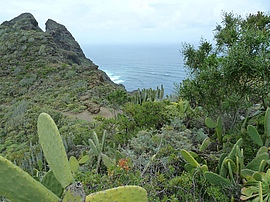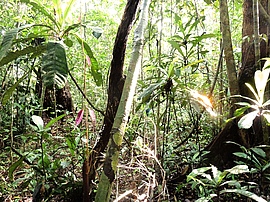Research
We work on different research projects in the EA group.
Microevolution and Macroevolution
Malagasy frugivory. We aim to understand the micro-evolutionary / genomic consequences of dispersal limitation of plants (palms in particular) on Madagascar. Giant lemurs and elephants birds went extinct ca. 2000 years ago. These animals were probably important seed dispersers, especially for plants with very large, fleshy fruits. Nowadays, only lemurs and a couple of bird species comprise the furgivory communities on Madagascar. Dispersal limitation may lead to low genetic diversity, low connectivity between populations and (historical) genetic bottlenecks. We study these processes using population-level Rad-seq data, in combination with functional trait, species-interaction and (historical) environmental data.
Historical habitat connectivity and evolution of chimpanzees. Using paleoclimate, genomic data and species distribution modelling, we investigate the environmental and evolutionary processes affecting chimpanzee diversification. In turn this helps us understand their complex genetic and cultural diversity, simultaneously providing essential conservation data for our closest living relative.
Evolutionary radiations. Our group uses a wide range of phylogenetic comparative methods to investigate the evolution of lineages and clades through time. Central questions include: when did lineages evolve? When did they colonise (new) continents or regions? Have there been shifts in diversification rates? Can changes in diversification rates be explained by traits, (extrinsic) ecological opportunities, or a combination of these? When did certain traits or trait syndromes evolve? Typical clades to address these questions in, include angiosperms in Mediterranean-type ecosystems (e.g. Rhamnaceae, Proteaceae), tropical rainforests (e.g. Arecaceae, Annonaceae), or islands (e.g. angiosperms that evolved secondary woodiness) but we are also interested in other taxonomic groups, such as birds, primates (e.g. lemurs - Lemuriformes) and frogs.
Macroecology and Functional Convergence
Trait dependent extinctions. We study which functional plant traits may be good predictors of species extinction risks across biodiversity hotspots - similar to large body sizes in animals. We collaborate with the sPlot consortium for this - investigating communities, their traits and the evolution of these traits on the angiosperm phylogenetic tree. We expect that species with traits related to 'slow' life history strategies (e.g. large, heavy seeds, biotic dispersal, sclerophyllous leaves, high wood densities) are more often threatened with extinction than those with 'fast' strategies (e.g. fast growth rates, non-sclerophyllous leaves, wind-dispersal). In addition, we investigate how (dispersal) traits affect range sizes and colonisation abilities.
Global convergence patterns. In terms of evolution and convergence, we ask whether regions with similar environmental conditions (e.g. climates) have selected independently and repeatedly for similar functional types (e.g. secondary woodiness in dry areas and/or islands, sclerophyllous leaves in Mediterranean-type ecosystems, succulence in deserts, etc.) while correcting for the phylogenetic dependence of data points and rapid in-situ radiations in these biomes. We evaluate the emergence of these convergence patterns through geological time.
Trait-based approaches. Our research often uses a trait-based approach to investigate the interaction between ecology and evolution. For this we are interested in building, using or contributing to trait databases such as the TRY database. We combine traits with distribution and genetic data to obtain a better understanding of the adaptation and/or exaptation of traits to particular environmental conditions (e.g. climate, soil, species-interactions).



